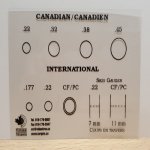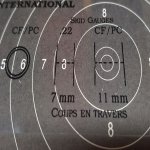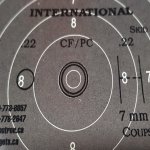For newbies to scoring targets, (including me), I thought I would provide a review of scoring gauges for group ragged holes (as opposed to single shot mini bulls which are easily scored with plug gauges), based on what I have recently learned. Experienced match shooters will be well familiar with all of this, so your added advice is very welcome.
For newbs to match scoring, on quality target paper the bullet punches out a hole smaller than the bullet diameter, and pushes in petals of paper that will show a carbon smear ring. That outer carbon ring is the bullet diameter and is what marks the true hit edge. On poor quality paper that is too thin, the bullet can punch out a hole or make a tear larger than the bullet diameter. So, in both cases scoring gauges are needed for the details.
I recently started shooting aperture sights at 50m. So far, I have only shot only benchrest discipline (later I will try 3-P disciplines). Due to the size of the aiming bulls and size of the paper needed for aperture sights, its necessary to shoot 5-shots per bull. The standard ISSF 50m target has 4 bulls for record, 5 shots each for 50 max points, total 200 max points per sheet.
In benchrest with the fully supported rifle, the 50m 5-shot groups can be amazingly small if the wind is not too bad, causing ragged holes that blow out the paper along with the fine scoring rings in the 10 and X ring area. The .22 scoring plugs we all use and which all clubs have for single shot scoring, may not work accurately when there is a mess of a ragged group hole for those tiny ISSF 10 and X rings.
For example, photo 1 is a 50m target I shot yesterday that shows a 5-shot hole in that 10 and X ring area that would be difficult for a plug to score accurately. Some holes are easy, some not so easy. How did I determine the 49-4X score? In this case the 49 looks solid, but am I confident its not 3X or 2X?
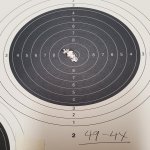
So I just bought two new (to me), scoring gauges I found online at Cibles: A magnifier viewer scoring device, and a simple transparent card overlay gauge. Problem solved! These work great!
One is a .17 and .22 rimfire caliber magnifier gauge (costs more), and one is a mixed caliber transparent card (inexpensive, buy a few).
Photo 2 below is the magnifier gauge. It contains 2 ring gauges: a single .17 caliber ring, and a .22 caliber double ring. The .22 gauge inner ring is to center the gauge on the smaller diameter punched-out hole. The outer ring is the true .22 diameter for indicating the hit edge for the carbon smear. See Photo 3 and 4 for examples.
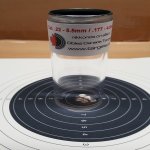
Photo 3 below is looking through magnifier at an example showing how the gauge clearly shows that the highlighted round cut the X-ring on the 50m ISSF target, so it scores 10-X. (Ignore the .17 caliber gauge ring). The reflection and blurriness around the sides looks bad in the photo but that is a camera effect of my cell phone snapshot. With your eye things are very clear.
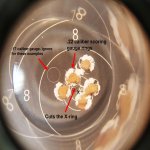
Photo 4 below shows looking through the magnifier at a close call for the highlighted round. Without a scoring gauge it can be an uncertain call. In this case I read the gauge to say no, the round did not cut the X-ring and score remains a 10, no X. The paper on that inner white ring is not physically cut, but the carbon smear could be there. But in this case the gauge appears to indicate no it was not touched by the round.
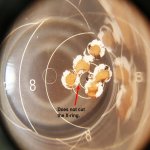
End of part 1. Please see the next post for the transparent gauge card and questions I have about how these work.
For newbs to match scoring, on quality target paper the bullet punches out a hole smaller than the bullet diameter, and pushes in petals of paper that will show a carbon smear ring. That outer carbon ring is the bullet diameter and is what marks the true hit edge. On poor quality paper that is too thin, the bullet can punch out a hole or make a tear larger than the bullet diameter. So, in both cases scoring gauges are needed for the details.
I recently started shooting aperture sights at 50m. So far, I have only shot only benchrest discipline (later I will try 3-P disciplines). Due to the size of the aiming bulls and size of the paper needed for aperture sights, its necessary to shoot 5-shots per bull. The standard ISSF 50m target has 4 bulls for record, 5 shots each for 50 max points, total 200 max points per sheet.
In benchrest with the fully supported rifle, the 50m 5-shot groups can be amazingly small if the wind is not too bad, causing ragged holes that blow out the paper along with the fine scoring rings in the 10 and X ring area. The .22 scoring plugs we all use and which all clubs have for single shot scoring, may not work accurately when there is a mess of a ragged group hole for those tiny ISSF 10 and X rings.
For example, photo 1 is a 50m target I shot yesterday that shows a 5-shot hole in that 10 and X ring area that would be difficult for a plug to score accurately. Some holes are easy, some not so easy. How did I determine the 49-4X score? In this case the 49 looks solid, but am I confident its not 3X or 2X?

So I just bought two new (to me), scoring gauges I found online at Cibles: A magnifier viewer scoring device, and a simple transparent card overlay gauge. Problem solved! These work great!
One is a .17 and .22 rimfire caliber magnifier gauge (costs more), and one is a mixed caliber transparent card (inexpensive, buy a few).
Photo 2 below is the magnifier gauge. It contains 2 ring gauges: a single .17 caliber ring, and a .22 caliber double ring. The .22 gauge inner ring is to center the gauge on the smaller diameter punched-out hole. The outer ring is the true .22 diameter for indicating the hit edge for the carbon smear. See Photo 3 and 4 for examples.

Photo 3 below is looking through magnifier at an example showing how the gauge clearly shows that the highlighted round cut the X-ring on the 50m ISSF target, so it scores 10-X. (Ignore the .17 caliber gauge ring). The reflection and blurriness around the sides looks bad in the photo but that is a camera effect of my cell phone snapshot. With your eye things are very clear.

Photo 4 below shows looking through the magnifier at a close call for the highlighted round. Without a scoring gauge it can be an uncertain call. In this case I read the gauge to say no, the round did not cut the X-ring and score remains a 10, no X. The paper on that inner white ring is not physically cut, but the carbon smear could be there. But in this case the gauge appears to indicate no it was not touched by the round.

End of part 1. Please see the next post for the transparent gauge card and questions I have about how these work.




















































